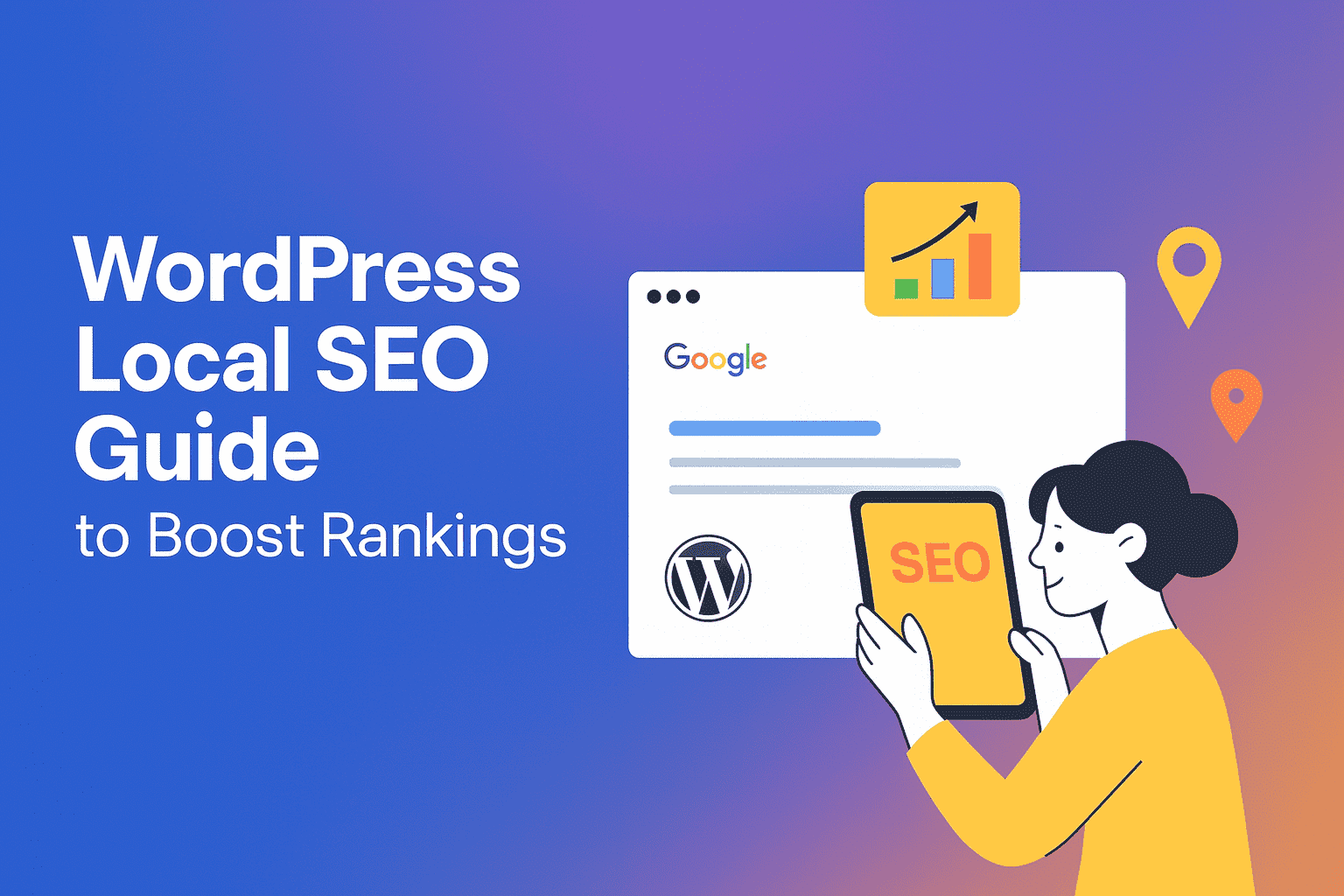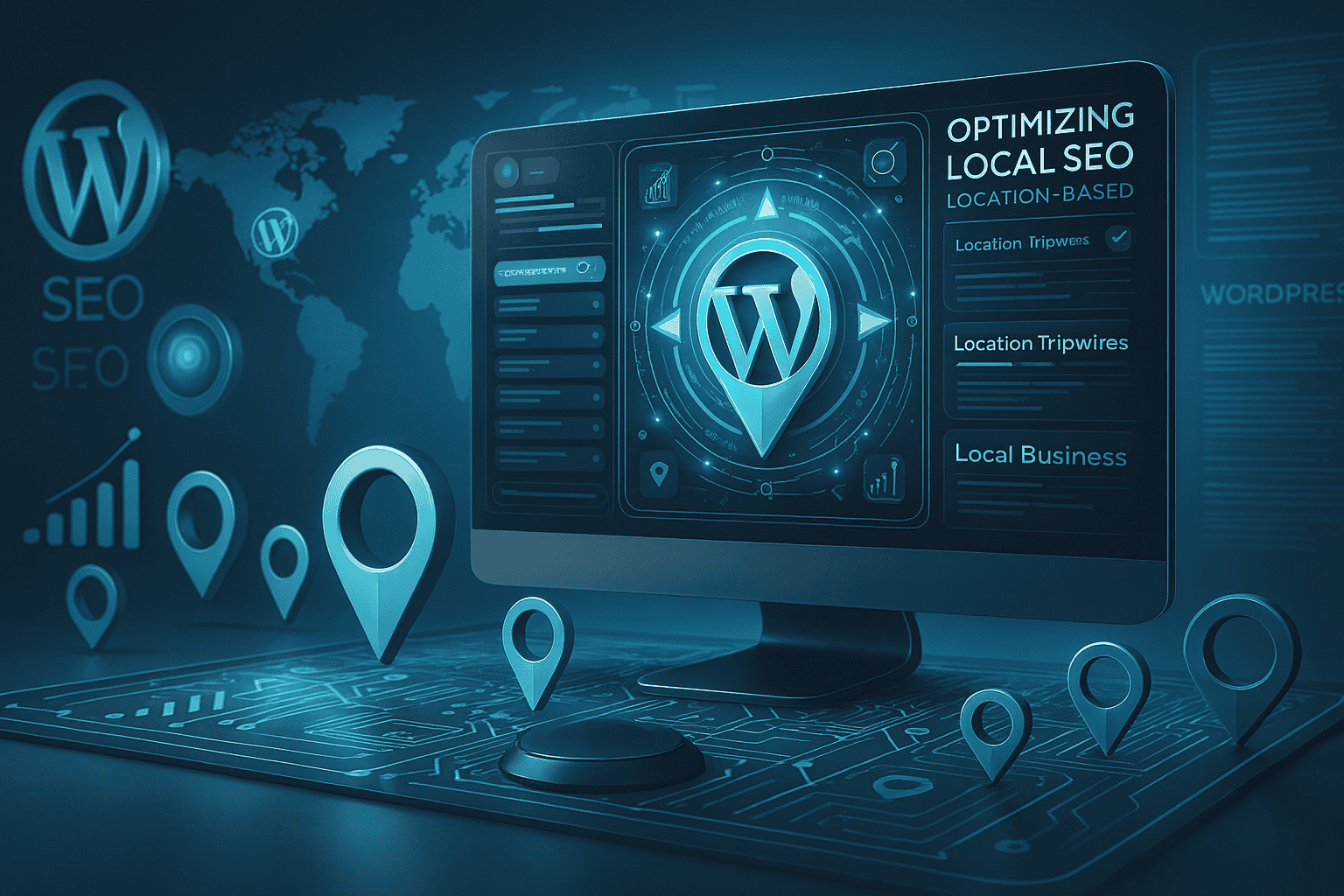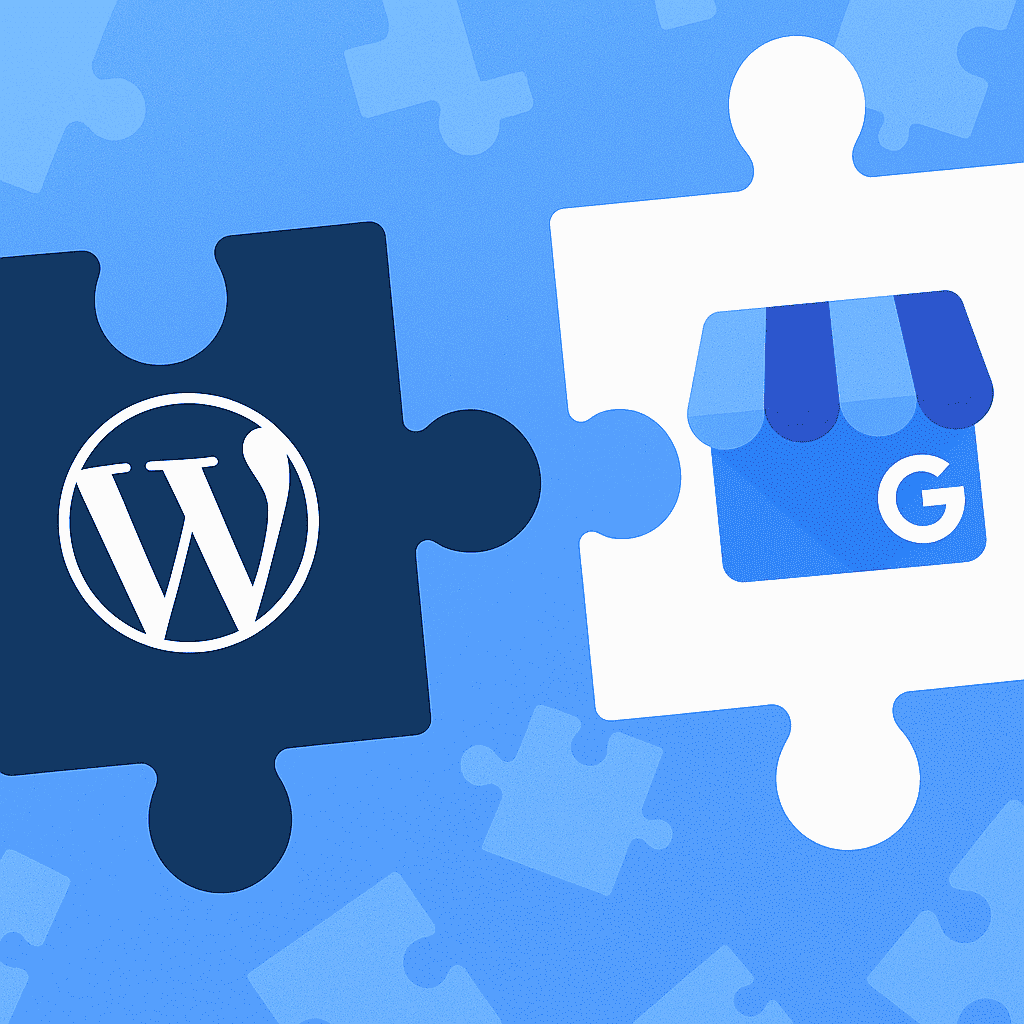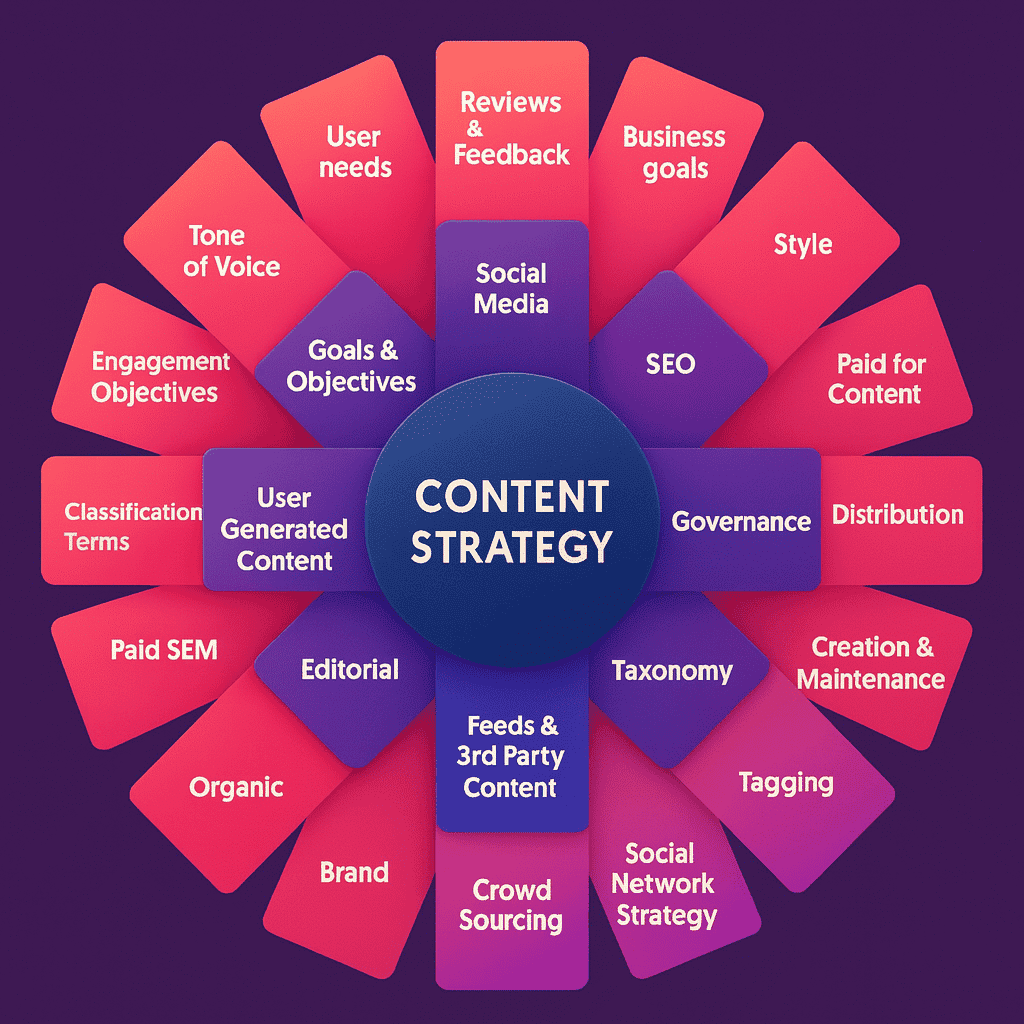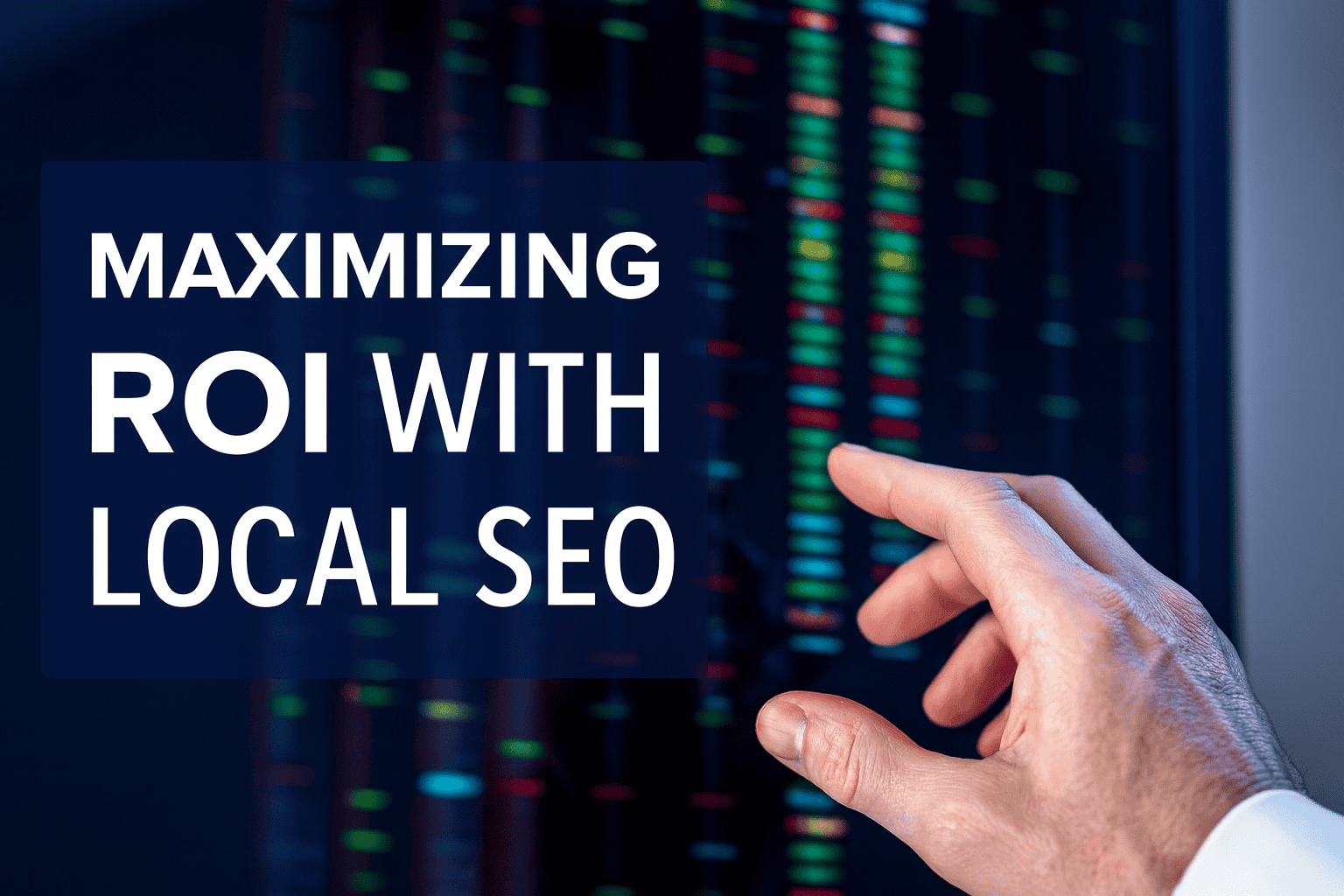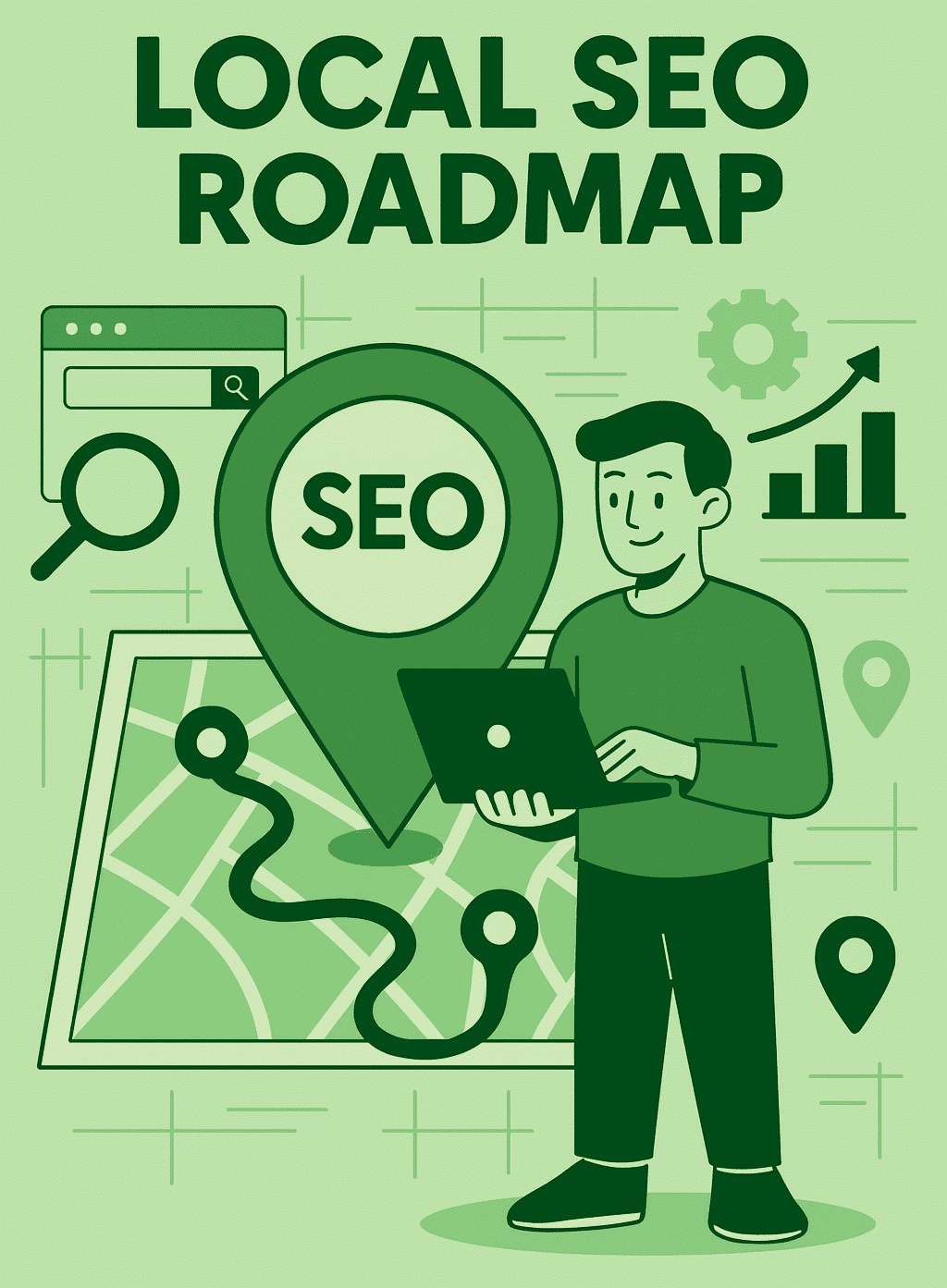The Ultimate Guide to WordPress Local SEO in 2025
TL;DR The term WordPress Local SEO refers to optimizing a WordPress website to improve its visibility in local search results on Google Search and Google Maps, focusing on relevance, distance, and prominence through native WordPress features and free Google tools, without relying on third-party plugins. This approach transforms the site into a powerful local authority hub, offering benefits such as driving qualified traffic and leads, enhancing AI search rankings (including voice search) (up to 47% of queries), and increasing foot traffic for businesses. Key strategies include creating location-specific pages with optimized content and schema markup, conducting hyper-local keyword research, integrating with Google Business Profile for mutual reinforcement, and developing expert content, such as blogs and visuals. Success is measured via tools like Google Search Console and Analytics, with tips tailored for various business types to achieve dominance in locally by 2025.
Table of Contents
- Introduction: The 2025 Local Search Landscape & Why WordPress is Your Strongest Asset
- Part 1: Foundational On-Site Local SEO: Building Your WordPress Hub
- Part 2: Strategic Integration of WordPress and Google Business Profile (GBP)
- Part 3: Advanced Local Content Marketing Strategies for WordPress
- Part 4: Measuring Local SEO Success & ROI with Free Tools
- Appendix: Resources & Checklists
What Is WordPress Local SEO?
WordPress Local SEO refers to the strategic optimization of a WordPress website to enhance its visibility in local search results on platforms like Google and Google Maps, utilizing built-in WordPress features and Google’s free tools to emphasize relevance and prominence through tactics such as creating location-specific pages, conducting targeted local keyword research, and manually implementing schema markup— all without depending on external SEO plugins. This approach offers numerous advantages for businesses aiming to dominate their local markets, including:
- Targeting location-specific keywords to boost relevance in local searches (and voice search)
- Enhancing user experience with area-tailored content that increases engagement and conversion rates.
- Strengthening the legitimacy of Google Profile Business listings via dedicated location pages that affirm physical presence.
- Establishing topical and geographic authority to position the business as a key local player.
- Attracting qualified traffic from Google Maps to the site, thereby improving lead generation and market share.
- Fostering a mutually reinforcing ecosystem with a Google Profile, where each element amplifies the other’s effectiveness.
The 2025 WordPress Local Rankings Landscape
As of July 2025, the digital landscape for local businesses has undergone a seismic shift. The battle for customers is no longer just about being listed; it’s about being *chosen*. This battle is overwhelmingly won or lost on Google, and more specifically, within the dynamic, AI-driven ecosystem of Google and Google Maps. For businesses ranging from the neighborhood plumber to the downtown law firm, your WordPress website has evolved from a simple online brochure into your most critical strategic asset—your digital command center.
The introduction of Google’s AI Overviews (formerly Search Generative Experience) has fundamentally altered the Search Engine Results Page (SERP). Users are increasingly receiving direct, synthesized answers to their queries, often reducing the need to click through to multiple websites. A recent study highlighted that AI Overviews now appear in up to 47% of Google searches, a figure that has grown by 115% since the March 2025 core update (WPBeginner Research). This trend might seem daunting, but it presents a clear opportunity: Google’s AI relies on authoritative, well-structured, and highly relevant web content to generate these summaries. A meticulously optimized WordPress website is your primary tool to influence these results and establish your business as the definitive answer for local queries.
This guide is crafted with a singular purpose: to provide a definitive, actionable framework for local businesses to leverage their *native WordPress capabilities* to dominate local search and Google Maps. We will deliberately steer clear of reliance on third-party SEO plugins or expensive analytical suites. The strategies outlined here are built on the foundational, often-overlooked power of WordPress itself, combined with Google’s free suite of tools. The core principle is simple yet profound: Google’s local algorithm is fundamentally built on three pillars: Relevance, Distance, and Prominence (Help). While you cannot change your physical distance from a customer, your WordPress web site is the ultimate tool for proving your relevance and building your prominence.
Throughout this comprehensive report, we will explore these strategies through the lens of three distinct business models, providing tailored examples and tactics for each:
- Service Area Businesses (SABs): Professionals who travel to their customers, such as plumbers, electricians, and mobile pet groomers. Their challenge is proving relevance across a wide geographic area without a single customer-facing storefront.
- Professional Services: Practitioners with a physical office where they meet clients, such as lawyers, doctors, dentists, and consultants. Their goal is to establish deep expertise and trust within a specific community.
- Brick-and-Mortar Retail: Physical stores, cafes, and boutiques that rely on foot traffic. Their success depends on capturing “near me” searches and driving in-store visits.
By mastering the techniques in this guide, you will transform your WordPress website from a passive digital presence into an active, lead-generating engine that systematically captures market share and solidifies your position at the top of Google Maps.
Part 1: Foundational WordPress On-Site Local SEO
Before your business can achieve dominance in the Google Maps “local pack,” your WordPress website must serve as an unimpeachable source of truth about your local authority. It is the foundation upon which your entire local SEO strategy is built. This section is dedicated to the essential, non-plugin, on-site fundamentals that transform a generic website into a hyper-local, search-optimized hub. We will deconstruct the process of understanding local customer intent, architecting powerful location-specific pages, and communicating directly with search engines through manual schema implementation—all using the native tools within WordPress.
Mastering Local Keyword Research & Intent (Without Paid Tools)
Effective local SEO begins with understanding the precise language your customers use when they need your products or services. This process, known as keyword research, doesn’t require expensive software. Google itself provides a suite of free, powerful tools that offer a direct line into the mind of the local consumer. The goal is not just to find target keywords, but to understand the *intent* behind them, so that I create a true, strong online presence.
Uncovering Keywords with Google’s Native Tools
Your primary research tools are built directly into the Google search experience. By using them systematically, you can build a comprehensive list of terms that real people are actively searching for.
- Google Autocomplete (Google Suggest): This is your starting point. Begin by typing a core service or product into the Google search bar, followed by a location. Observe the suggestions that appear before you hit enter. These are not random; they are based on popular, real-world searches.
- Example (Plumber): Type “plumber in downtown tampa”. Google might suggest “plumber in downtown tampa fl,” “emergency plumber in downtown tampa,” “24 hour plumber downtown tampa.”
- Example (Lawyer): Type “family law attorney miami”. Suggestions could include “family law attorney miami free consultation,” “best family law attorney miami,” “divorce attorney miami.”
- “People Also Ask” (PAA): After performing a search, look for the PAA box. This is a goldmine for understanding the questions and follow-up queries your potential customers have. Each question represents a potential content topic for a blog post or an FAQ page on your site. According to a guide on leveraging PAA, these questions reveal the user’s journey and informational needs (WPSlimSEO).
- Example (Retail Bike Shop): A search for “bike shop austin tx” might yield PAA questions like “What is the best bike trail in Austin?”, “Do bike shops do tune-ups?”, “How much does a bike rental cost in Austin?”.
- “Related Searches”: At the bottom of the search results page, Google provides a list of related searches. This is invaluable for discovering semantic keywords and alternative phrasing.
- Example (Plumber): Related searches for “plumber in downtown tampa” might include “tampa plumbing services,” “leak detection tampa,” “water heater repair tampa fl.”
Decoding Local Search Intent (coding required)
A keyword is more than a phrase; it’s a question or a need. Understanding the user’s intent is critical for creating content that satisfies them, which is a primary ranking factor (Wishpond Blog). Local search intent generally falls into three categories:
- Transactional Intent (High Urgency): The user is ready to hire or buy. These queries often include modifiers like “near me,” “open now,” “emergency,” or service-specific terms like “quote,” “cost,” or “repair.”
- Keywords: “emergency electrician phoenix,” “24/7 plumber brooklyn,” “find a dentist near me.”
- Your WordPress Strategy: These keywords should map directly to your core service pages or location pages. The content must be direct, with clear calls-to-action (CTAs) like “Call Now” or “Request a Quote.”
- Informational Intent (Research Phase): The user is looking for information, not necessarily ready to purchase. They are asking “how,” “what,” “why,” or “best.”
- Keywords: “how to fix a running toilet,” “what to look for in a personal injury lawyer,” “best running shoes for flat feet.”
- Your WordPress Strategy: These keywords are perfect for blog posts, guides, and FAQ pages. By answering these questions, you build trust and establish your business as a local expert.
- Navigational Intent: The user is trying to find your specific business. They are searching for your brand name.
- Keywords: “[Your Business Name],” “[Your Business Name] hours,” “[Your Business Name] reviews.”
- Your WordPress Strategy: Your homepage and contact page must be perfectly optimized for your brand name to capture this traffic.
Framework for Mapping Keywords to Your Site
Once you have your list of keywords and have identified their intent, you need to organize them. A structured approach ensures that every page on your site has a clear purpose. Use a simple spreadsheet to map your keywords.
| Keyword/Query | Estimated Monthly Searches (Qualitative: High/Med/Low) | Search Intent | Target WordPress Page | Content Angle |
|---|---|---|---|---|
| emergency plumber downtown tampa | Medium | Transactional | /locations/downtown-tampa/ | Highlight 24/7 service, fast response times, direct contact info. |
| how to unclog a kitchen sink | High | Informational | /blog/how-to-unclog-kitchen-sink/ | DIY guide with a soft CTA: “If this doesn’t work, call the experts.” |
| ABC Plumbing tampa reviews | Low | Navigational | /testimonials/ or Homepage | Showcase customer reviews and build trust. |
| best personal injury lawyer miami | Medium | Informational/Transactional | /practice-areas/personal-injury/ | Page detailing expertise, case results, and client testimonials. |
| bike repair shop austin | High | Transactional | /services/bike-repair/ | List of repair services, pricing, and turnaround times. |
By following this manual but highly effective process, you create a content and site structure strategy that is directly aligned with what your customers are looking for. This foundation is non-negotiable for success in the 2025 local search environment.
Architecting For Local Customers Pages in WordPress
For any business with a physical presence or a defined service area, the single most powerful on-site signal you can send to Google (and other search engines) is a dedicated, unique, and richly detailed page for each location or primary service area. These pages, often called “city pages” or “location pages,” act as individual digital storefronts. They tell Google unequivocally: “I am an expert and I operate *here*.” Creating these pages within WordPress is a straightforward process that, when done correctly, yields significant ranking benefits, especially for multi-location businesses or service-area businesses targeting several distinct communities (Search Engine Journal).
Why Location Pages Are Crucial in 2025
In an era of hyper-personalization and AI-driven results, generic content fails. A single “Contact Us” page with a list of addresses is insufficient. Dedicated location pages are critical because they:
- Target Location-Specific Keywords: A page for “Tampa” can be optimized for “plumber in Tampa,” while a page for “St. Petersburg” can target “plumber in St. Petersburg,” preventing keyword cannibalization and increasing relevance for each search.
- Improve User Experience (UX): A user searching from a specific area lands on a page that speaks directly to them, featuring local information, testimonials, and a map to their nearest location. This increases engagement and conversion rates.
- Provide Strong Signals for Google Maps: Each location page, with its unique URL and embedded map, reinforces the legitimacy and physical presence of your corresponding Profile listing.
- Build Topical and Geographic Authority: A well-structured set of location pages demonstrates to Google that you are a prominent entity within a broader region.
How to Build a High-Performance Location Page in WordPress
The process involves creating a new page for each location and meticulously optimizing its content. Here is the step-by-step guide using the native WordPress editor.
Step 1: Create a New Page
In your WordPress dashboard, navigate to Pages > Add New Page. This will open the block editor where you will build your location page.
Step 2: Define a Clear and Optimized URL Structure
Before you even write content, set the page’s URL (permalink). A logical structure is vital. A recommended structure is `yourdomain.com/locations/city-name/` or `yourdomain.com/service-area/city-name/`. For example:
- `abcpumbling.com/locations/tampa/`
- `smithlawfirm.com/offices/miami/`
- `bestbikes.com/stores/austin/`
You can edit the permalink in the “Summary” panel on the right side of the WordPress editor.
Step 3: Craft Essential On-Page Elements
This is where you build the substance of the page. Each element must be tailored to the specific location.
A. Title Tag and H1 Heading
The page title is the most important on-page SEO element. It should be set within your theme’s settings or, if your theme doesn’t provide an explicit field, the page title you enter in the WordPress editor will typically be used. The H1 is the main heading on the page itself. Both should include your primary service and the specific location.
- Page Title (SEO Title): `Emergency Plumbing Services in Downtown Tampa | ABC Plumbing`
- H1 Heading (On-Page Title): `Your Trusted 24/7 Plumber in Downtown Tampa`
B. NAP Consistency (Name, Address, Phone Number)
Your business Name, Address, and Phone number must be displayed on this page. Crucially, it must be 100% identical to the information on your corresponding GMB Profile listing. Even minor variations (e.g., “St.” vs. “Street,” “Suite” vs. “#”) can confuse search engines (Semrush). Add this information clearly in a standard Text block near the top of the page or in the footer/sidebar area dedicated to this location.
ABC Plumbing – Tampa
123 Main Street Tampa, FL 33602 (813) 555-1234
C. Embedded Google Map
Visually confirming your location with an embedded map is a powerful trust signal for both users and search engines. To do this without other plugins:
- Go to Google Maps and search for your exact business location.
- Click the “Share” button.
- Select the “Embed a map” tab.
- Copy the provided HTML `
- In your WordPress editor, add a “Custom HTML” block and paste the code into it.
This will display an interactive map directly on your page, reinforcing the address you provided in text.
D. Unique, Hyper-Local Content
This is what separates a great location page from a poor one. The content must be unique to this location. Avoid copying content from other pages and simply swapping the city name. Ideas for unique content include:
- For a Service Area Business (Electrician in Scottsdale): “We are proud to serve the homeowners of Scottsdale, from the historic Old Town to the newer communities in North Scottsdale. We understand the specific electrical challenges of this area, including wiring in older homes and surge protection needs during monsoon season.”
- For a Professional Service (Dentist in Brooklyn): “Our Brooklyn office is conveniently located near the Barclays Center, easily accessible via the 2, 3, 4, and 5 trains. We have been a part of the Park Slope community for over 15 years, providing family dentistry to our neighbors.”
- For a Retail Store (Bookstore in Portland): “Come visit our store in the heart of the Pearl District! After you browse our shelves, you can grab a coffee at one of the many nearby cafes or take a stroll through Jamison Square Park, just two blocks away.”
E. Local Testimonials and Reviews
Social proof is incredibly persuasive. Manually add 2-3 of your best customer reviews from clients in that specific location. You can use the WordPress “Quote” block to make them stand out. Be sure to mention the customer’s first name and city to add authenticity.
“ABC Plumbing was a lifesaver! They arrived at our Tampa Heights home in 30 minutes and fixed our burst pipe. Highly recommend!”
– Sarah J., Tampa Heights
F. Locally Optimized Images and Videos
Visuals add immense value. Use photos of your team working on a job in that city, pictures of your storefront, or images of local landmarks near your office. When you upload these to the WordPress Media Library, optimize them for local technical SEO:
- File Name: Before uploading, rename the file to be descriptive. Instead of `IMG_1234.jpg`, use `plumber-fixing-sink-tampa-fl.jpg`.
- ALT Text: Add descriptive ALT text in the WordPress media editor. For the example above, the ALT text could be “ABC Plumber fixing a kitchen sink in a Tampa home.” This helps search engines understand the image’s context.
Implementing Local Business Schema Manually
Schema markup is a vocabulary of code that you add to your website’s HTML to help search engines understand your content more effectively. Think of it as a direct line of communication to Google, clarifying exactly what your business is, where it’s located, what it does, and when it’s open. While many plugins automate this, implementing it manually in WordPress gives you complete control and avoids plugin bloat. The most common and effective format is JSON-LD (RankMath).
What is JSON-LD and Why Use It?
JSON-LD (JavaScript Object Notation for Linked Data) is Google’s recommended format for structured data. It’s a script that you can place anywhere in the HTML of your page (usually in the “ or near the end of the “), and it doesn’t interfere with the visible content on your page. This makes it clean and easy to manage.
How to Add Local Business Schema to a WordPress Page
The process is simple: generate the code, customize it with your business details, and add it to the relevant page using a Custom HTML block.
Manual Schema Implementation Workflow
Step 1: Generate Base Schema Code
↓
Step 2: Customize with Your Specific Business Information (NAP, Hours, etc.)
↓
Step 3: Copy the Final JSON-LD Code
↓
Step 4: Paste into a “Custom HTML” Block on the Relevant WordPress Page
↓
Step 5: Update the Page and Test the URL with Google’s Rich Results Test
Schema Templates for Different Business Types
Here are copy-and-paste templates for our three business models. Replace the bracketed `[placeholder]` text with your actual information.
Template 1: For a Service Area Business (e.g., Plumber)
This schema uses the `Plumber` type and defines a `serviceArea` instead of a single address.
<script type="application/ld+json">
{
"@context": "https://schema.org",
"@type": "Plumber",
"name": "[ABC Plumbing]",
"image": "[URL_of_your_logo_or_a_representative_image.jpg]",
"@id": "[URL_of_your_website]",
"url": "[URL_of_your_website]",
"telephone": "[+1-813-555-1234]",
"priceRange": "$$",
"address": {
"@type": "PostalAddress",
"streetAddress": "[123 Main Street]",
"addressLocality": "[Tampa]",
"addressRegion": "[FL]",
"postalCode": "[33602]",
"addressCountry": "US"
},
"geo": {
"@type": "GeoCoordinates",
"latitude": 27.9506,
"longitude": -82.4572
},
"openingHoursSpecification": [
{
"@type": "OpeningHoursSpecification",
"dayOfWeek": [
"Monday",
"Tuesday",
"Wednesday",
"Thursday",
"Friday"
],
"opens": "00:00",
"closes": "23:59"
},
{
"@type": "OpeningHoursSpecification",
"dayOfWeek": [
"Saturday",
"Sunday"
],
"opens": "00:00",
"closes": "23:59"
}
],
"serviceArea": {
"@type": "GeoShape",
"description": "We serve the greater Tampa Bay area, including Hillsborough and Pinellas counties.",
"geo": [
{
"@type": "GeoCoordinates",
"postalCode": "33602"
},
{
"@type": "GeoCoordinates",
"postalCode": "33701"
}
]
}
}
</script>
Template 2: For a Professional Service (e.g., Medical Clinic)
This schema uses the `MedicalClinic` type and can include details like accepted insurance.
<script type="application/ld+json">
{
"@context": "https://schema.org",
"@type": "MedicalClinic",
"name": "[Miami Health Clinic]",
"description": "A leading family medical clinic in Miami, FL offering comprehensive healthcare services.",
"image": "[URL_of_your_clinic_image.jpg]",
"url": "[URL_of_your_clinic_website]",
"telephone": "[+1-305-555-5678]",
"address": {
"@type": "PostalAddress",
"streetAddress": "[456 Ocean Drive]",
"addressLocality": "[Miami]",
"addressRegion": "[FL]",
"postalCode": "[33139]",
"addressCountry": "US"
},
"openingHours": "Mo-Fr 09:00-17:00",
"hasMap": "[URL_to_your_Google_Map_listing]",
"acceptsReservations": "True",
"healthPlanNetworkId": ["Aetna", "Cigna", "BlueCross"]
}
</script>
Template 3: For a Brick-and-Mortar Retail (e.g., Store)
This schema uses the `Store` type and can include payment methods accepted.
<script type="application/ld+json">
{
"@context": "https://schema.org",
"@type": "Store",
"name": "[Austin Bike Co.]",
"image": "[URL_of_your_storefront_image.jpg]",
"url": "[URL_of_your_store_website]",
"telephone": "[+1-512-555-8765]",
"priceRange": "$$$",
"address": {
"@type": "PostalAddress",
"streetAddress": "[789 Congress Ave]",
"addressLocality": "[Austin]",
"addressRegion": "[TX]",
"postalCode": "[78701]",
"addressCountry": "US"
},
"openingHoursSpecification": {
"@type": "OpeningHoursSpecification",
"dayOfWeek": [
"Monday",
"Tuesday",
"Wednesday",
"Thursday",
"Friday",
"Saturday"
],
"opens": "10:00",
"closes": "19:00"
},
"paymentAccepted": "Cash, Credit Card, Apple Pay"
}
</script>
After adding the appropriate schema to your location page(s), publish the page. Then, take the page’s URL and test it using Google’s Rich Results Test to ensure there are no errors. A valid result confirms that Google can read and understand your structured data, a critical step in solidifying your local SEO foundation.
Part 2: Strategic Integration of WordPress and Google My Business Profile (GBP)
Your site and your GBP are not isolated marketing channels; they are two halves of a powerful local marketing engine. When they operate in sync, they create a virtuous cycle—a feedback loop where each platform strengthens the other. Your website provides the depth, authority, and content that Google needs to trust your GBP listing, while your GBP provides the high-visibility entry point that drives qualified local traffic to your website. This section details the strategies to forge this critical connection, turning two separate profiles into a single, cohesive system for local dominance.
Establishing the Foundational Connection
The most fundamental step is ensuring a clean, direct link between your GBP and your website. This may seem basic, but errors here are common and can undermine your entire strategy.
The Website URL: Your Digital Handshake
In your GBP Profile dashboard, the “Website” field is your primary digital handshake with Google. It’s the link that validates your online presence.
- For Single-Location Businesses: The URL should almost always be your homepage (e.g., `https://www.abcpumbling.com`). This establishes your main domain as the central hub of authority.
- For Multi-Location Businesses: For each individual location’s GBP listing, the website URL should point directly to the corresponding location-specific page on your website (e.g., `https://www.abcpumbling.com/locations/tampa/`). This creates a direct, unambiguous link between the physical listing and its digital counterpart, maximizing relevance for location-based searches.
To implement this, log in to your Google Business Profile Manager, select the correct location, navigate to the “Info” tab, and edit the website field. Ensure the URL is correct, including `https://`, and is free of any tracking parameters that could confuse crawlers.
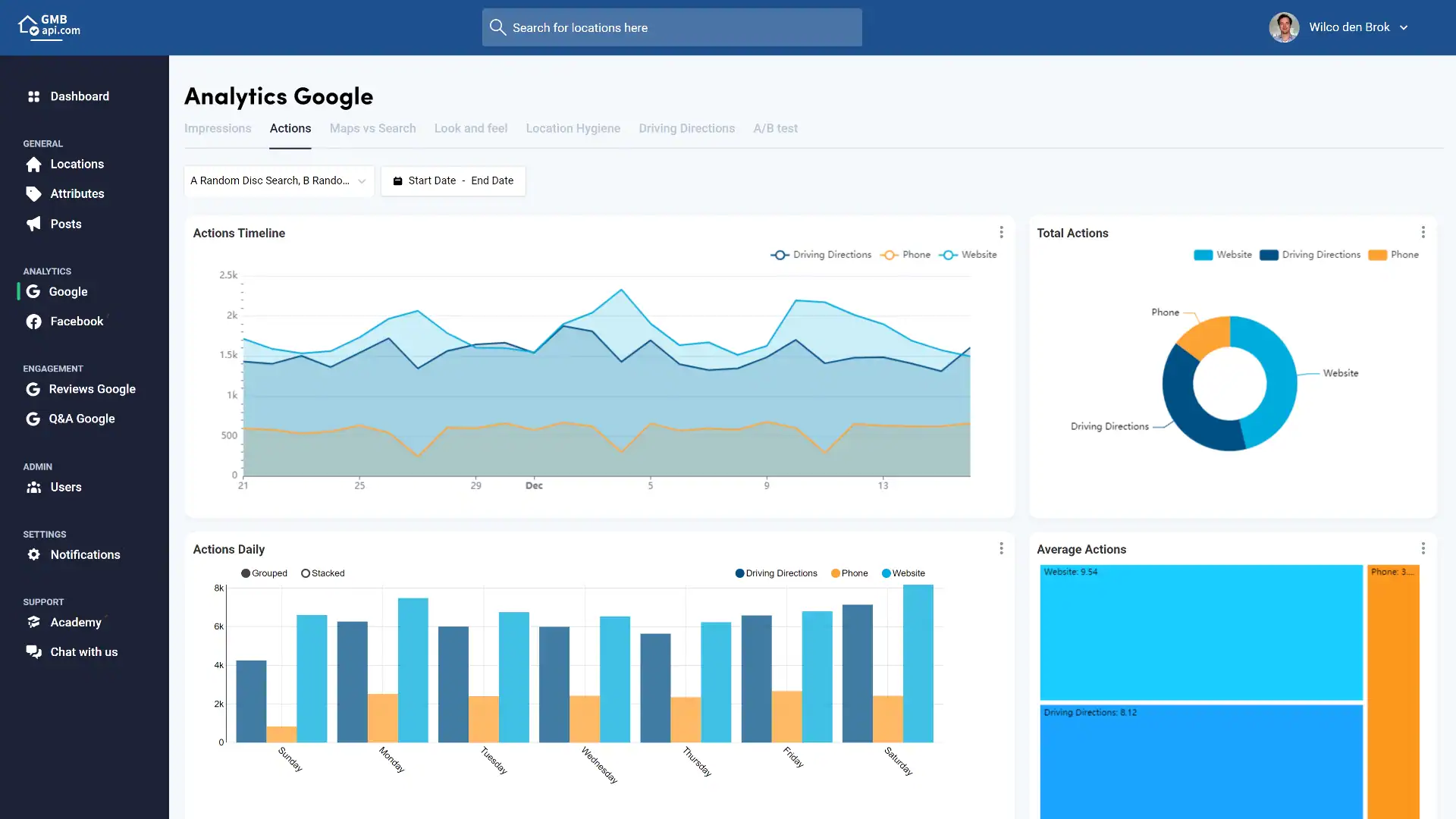
The Google Business Profile dashboard is where you manage your business’s core information, including the crucial website link that connects to your WordPress site
Leveraging GBP Features to Fuel WordPress Content
Your GBP is a live channel for customer interaction. These interactions are a rich source of all the data that should directly inform your WordPress content strategy. This creates a loop where customer needs expressed on Google are answered in-depth on your website.
GBP Questions & Answers: Your Target Audience’s FAQ
The Q&A section on your GBP is a direct reflection of your customers’ most pressing questions and information gaps. Monitor this section weekly.
- Strategy: When a new, relevant question is asked (e.g., “Do you offer financing for new AC units?”), answer it promptly and professionally on GBP. Then, use that question as a prompt to create a more comprehensive answer on your WordPress site. You can build a dedicated FAQ page (`/faq/`) or write a detailed blog post (`/blog/ac-unit-financing-options/`).
- Closing the Loop: After publishing the detailed answer on your website, you can even go back to the original question on GBP and add a comment to your answer: “For a more detailed breakdown of our financing plans, you can read our full guide here: [link to your new WordPress page].”
GBP Reviews: Sourcing Authentic, Local Content
Customer reviews are not only a local search ranking factor but also a source of powerful, keyword-rich, and authentic content (MARA AI). Manually embedding these reviews on your website builds immense social proof.
- Strategy: Identify standout reviews, especially those that mention specific services or locations (e.g., “Jane from the South Austin office was amazing in handling my case.”). Copy the text of this review and feature it on the relevant WordPress page (the South Austin location page or the page for that specific legal service). Use the “Quote” block in WordPress to make it visually distinct.
- Benefit: This enriches your WordPress pages with user-generated content that often contains the exact long-tail keywords other potential customers are searching for.
GBP Posts: Your Content Distribution Channel
Think of GBP Posts as a free, high-visibility billboard pointing back to your authoritative content hub—your website. A common mistake is to create posts that live only on GBP. The best strategy is to use them as teasers for the rich content on your website.
- Strategy:
- Publish a detailed, valuable blog post on your site (e.g., a retail store writes “Our Guide to Choosing the Perfect Commuter Bike for City Living”).
- Create a GBP Post with an engaging image, a concise summary (100-200 words) of the blog post, and a clear call-to-action.
- Use the “Learn More” button option in the GBP Post to link directly to the full blog post on your WP site.
- Local Results: You drive traffic from a high-intent city audience on Google directly to your website, where you can further engage them, capture their information, or lead them to product pages.
Using WordPress to Enhance Your GBP Listing
The synergy flows both ways. The content and structure of your WP site should be actively used to enrich and validate the information on your GBP Profile.
Showcasing Products and Services
The “Products” and “Services” sections of your GBP are often underutilized. Use your WP site to build out detailed descriptions, and then populate your GBP listing with this information.
- Strategy: Create dedicated pages on your WP site for each core service (e.g., `/services/leak-detection/`, `/services/rooter-service/`). Write detailed descriptions, explain the process, and include pricing information if possible. Then, in your GBP dashboard, create corresponding service entries. Use the descriptions from your WordPress pages and, most importantly, add the direct URL to the relevant WordPress service page in the service entry. This allows users to click from your GBP service list directly to a page with in-depth information.
Visual Integration: A Consistent Brand Story
High-quality, locally-relevant photos are critical for engagement on GBP. Your WordPress Media Library can serve as the central repository for these assets.
- Strategy: When you take photos of a completed job, your storefront, or your team, follow this workflow:
- Optimize the image file name for local SEO (`law-firm-miami-office-interior.jpg`).
- Upload it to your WordPress Media Library.
- Add descriptive ALT text (“Interior of the Smith & Jones law firm office in Miami, FL”).
- Use this image on the relevant WordPress page (e.g., the Miami location page).
- Upload the *exact same optimized file* to your GBP Profile photo gallery.
- Benefit: This creates visual consistency across your digital properties and ensures your GBP is populated with high-quality, professionally managed images, rather than ad-hoc phone number-generated pictures.
WordPress-GBP Synergy Loop 1: GBP to WordPress
Customer asks a question on GBP
↓
Create detailed FAQ page or blog post on WordPress
↓
Answer question on GBP, linking back to the new WordPress content
WordPress-GBP Synergy Loop 2: WordPress to GBP
Publish in-depth blog post on WordPress
↓
Create a summary as a GBP Post
↓
Use “Learn More” button to link back to the full WordPress post
By implementing these integration strategies, you create a powerful, self-reinforcing system. Your WP site becomes the authoritative source that feeds and validates your GBP, while your GBP acts as the primary discovery and traffic channel, driving engaged your customers back to your site.
Part 3: Advanced Local Content Marketing Strategies for WordPress
Once your foundational on-site SEO and GBP integration are in place, content becomes the engine that drives your local relevance and authority. In 2025, generic, keyword-stuffed articles are ineffective. Success in local search requires creating content that demonstrates true local expertise, serves the community’s needs, and positions your small business as the go-to resource. Your WordPress site is the perfect platform to execute these advanced content strategies, moving beyond simple service descriptions to build a library of valuable, locally-focused assets.
Strategy 1: Creating “Local Expert” Blog Content
This strategy is about proving you understand the unique context of your service area. It involves writing blog posts that address problems, events, and topics specific to your local audience. This hyper-local content is highly valuable to both users and search engines, as it demonstrates a level of expertise that national chains or less-invested competitors cannot replicate.
Examples Across Business Types:
- For Service Area Businesses (Plumber in Phoenix, AZ):
- Title: “Common Hard Water Issues in Phoenix Homes and How to Fix Them”Content Angle: Discuss the specific mineral content in Phoenix’s water supply, show pictures of calcium buildup on fixtures, and explain how water softeners can help. This addresses a problem unique to the region.
- Title: “Case Study: A Full Repiping Project in a Historic Scottsdale Home”Content Angle: Document a real project with before-and-after photos. Discuss the challenges of working with older plumbing systems common in specific Scottsdale neighborhoods. This builds trust and showcases expertise.
- For Professional Services (Personal Injury Lawyer in Orlando, FL):
- Title: “Navigating Recent Changes to Florida’s No-Fault Insurance Laws”Content Angle: Translate complex legal updates into easy-to-understand language for Florida residents. Explain how the changes affect accident claims, establishing legal authority.
- Title: “What to Do After a Car Accident on I-4 in Orlando”Content Angle: Provide a practical, step-by-step guide that references specific, high-traffic areas known for accidents. Mention local police departments and resources, making the content immediately useful for someone in a stressful situation.
- For Brick-and-Mortar Retail (Bike Shop in Austin, TX):
- Title: “The Top 5 Family-Friendly Bike Trails Near Austin, TX”Content Angle: Create a detailed guide with maps, difficulty ratings, and photos for local trails like the Ann and Roy Butler Hike-and-Bike Trail. Position your shop as the starting point for these adventures.
- Title: “Customer Spotlight: Meet a Local Cyclist and Their Custom-Built Gravel Bike”Content Angle: Interview a real customer and tell their story. Showcase the bike you built for them and how it’s perfect for the terrain around Austin. This creates community and authentic content.
Strategy 2: Building Location-Specific Resource Hubs
A resource hub is a collection of interconnected pages on your WP site dedicated to a broad local topic. This positions your business as a central information source, attracting valuable top-of-funnel traffic. You can structure this easily in WordPress using Parent and Child pages.
How to Structure a Resource Hub in WordPress:
- Create a Parent Page: This is the main page of your hub (e.g., `/austin-relocation-guide/`). It should provide an overview of the topic and link out to all the child pages.
- Create Child Pages: For each sub-topic, create a new page. In the “Page Attributes” panel in the WordPress editor, select your main hub page as the “Parent Page.” This will create a logical URL structure (e.g., `/austin-relocation-guide/best-neighborhoods/`).
- Interlink Everything: The parent page should link to all child pages, and child pages should link back to the parent and to each other where relevant.
Example: A Real Estate Agent in Austin, TX
- Parent Page: “The Ultimate Austin Relocation Guide”
- Child Pages:
- `/austin-relocation-guide/best-neighborhoods-for-families/`
- `/austin-relocation-guide/top-school-districts/`
- `/austin-relocation-guide/local-utilities-setup/`
- `/austin-relocation-guide/austin-property-tax-information/`
Within each of these pages, the real estate agent can subtly weave in their expertise and services, offering to help with home searches in the discussed neighborhoods. This strategy attracts people before they are even looking for an agent, building trust early in the customer journey.
Strategy 3: Leveraging Local Events and News
Connecting your business to the pulse of the community is a powerful way to generate fresh, relevant content and earn valuable local backlinks (including local directories like Yellow Pages). Your WordPress blog is the ideal place to do this.
Implementation in WordPress:
- Create a “Community” or “Local Events” Category: In your WordPress dashboard, go to Posts > Categories and create a new category for this type of content.
- Write About Local Happenings:
- Sponsorships: If you sponsor a local little league team or a charity 5k, write a blog post about it. Include photos of your team at the event.
- Event Participation: If your business has a booth at the Dallas Farmers Market Festival, write a post previewing what you’ll be offering and another post recapping the event.
- Local News Tie-in: If a local newspaper reports on a new construction boom (for a contractor) or a new business regulation (for a consultant), write a blog post offering your expert perspective on the news.
This strategy not only creates content that is highly relevant to local search but also provides a natural reason for other local organizations (event organizers, news outlets, other businesses) to link back to your website.
Strategy 4: Creating Visual Local Assets
Visual content is highly engaging and shareable. Creating visual assets that are specifically tailored to your local area can set you apart and provide another layer of local relevance.
Types of Visual Assets and How to Use Them:
- Local Infographics: Use a free online tool like Canva to create a simple infographic. Upload it to your WordPress Media Library and embed it in a relevant blog post.
- Example (Electrician in Boston): An infographic titled “A Diagram of Common Electrical Issues in Historic Boston Brownstones,” showing knob-and-tube wiring vs. modern wiring.
- Project Videos: Film a short video of a project in a specific neighborhood. You can upload this to YouTube and then embed the video directly into your WordPress location page or a case study blog post.
- Example (Landscaper in San Diego): A time-lapse video of a backyard transformation in a La Jolla home, embedded on the `/service-area/la-jolla/` page.
Local Content Creation Process
Start: Identify a Local Customer Pain Point or Interest (e.g., “What are the best hiking trails?”)
↓
Keyword Research: Use Google Suggest (“hiking trails near me austin”) and PAA (“are austin trails dog friendly?”)
↓
Draft Post in WordPress: Create a new blog post titled “Top 5 Dog-Friendly Hiking Trails in Austin”
↓
Add Local Assets: Embed a Google Map of the trailheads and add your own photos of the trails.
↓
Publish & Promote: Publish the post on WordPress and create a summary GBP Post linking back to it.
By consistently executing these advanced content strategies, your WP site becomes more than just a business website; it becomes an indispensable local resource. This deep-seated relevance and authority is precisely what Google’s algorithms are designed to find and reward in 2025.
Part 4: Measuring Local SEO Success & ROI with Free Tools
Executing a sophisticated local SEO strategy is only half the battle; proving its value is equally important. Measuring your return on investment (ROI) justifies the time and resources spent and provides the data needed to refine your approach. You do not need expensive, complex analytics software to do this. By leveraging Google’s own free tools—Google Search Console, Google Business Profile Insights, and Google Analytics 4—you can build a powerful, data-driven picture of your local SEO performance.
Defining Your Key Performance Indicators (KPIs)
Before you can measure success, you must define what success looks like. For local SEO, KPIs fall into three main categories: Visibility, Engagement, and Conversion. Tracking metrics across all three provides a holistic view of your performance.
1. Visibility Metrics: Are People Seeing You?
These metrics indicate how frequently your business appears in front of more customers.
- Local Pack & Maps Rankings: Your position in the Google Maps “3-pack” for your most important keywords. This often requires a manual check from a browser in incognito mode to get an unbiased google search result.
- GBP Impressions (from GBP Insights): The total number of times your Google Business Profile was shown to users. This is broken down into “Search” (when your profile appears in standard search results) and “Maps” (when it appears directly in Google Maps).
- Website Impressions (from GSC): The number of times your WP site’s URLs appeared in search results for specific local queries.
2. Engagement Metrics: Are Same People Interacting?
More visibility is meaningless if users don’t take the next step. These metrics measure direct interactions with your online presence.
- Clicks to Website (from GBP Insights): The number of users who clicked the website link on your GBP listing, leading them to your WP site.
- Clicks for Directions (from GBP Insights): The number of users who clicked to get directions to your physical location. This is a powerful KPI for brick-and-mortar businesses.
- Clicks to Call (from GBP Insights): The number of users who clicked the call button on your GBP listing, especially from mobile devices. This is a high-intent action for service and professional businesses.
3. Conversion Metrics: Are You Generating Business?
This is the ultimate measure of success—turning visibility and engagement into tangible business outcomes.
- Website Goal Completions (from Google Analytics 4): Tracking specific actions on your WP site, such as contact form submissions, quote requests, or newsletter sign-ups.
- Attributed Revenue (for e-commerce): Directly tracking more sales that originated from organic search traffic.
Building Your Free Local SEO Dashboard (Conceptual)
You can consolidate data from these free tools into a simple monthly or quarterly report (e.g., in a spreadsheet) to track progress over time.
Using Search Console (GSC)
GSC is essential for understanding how your WP site performs in organic search. To track local performance:
- Go to the “Performance” report in GSC.
- Click “+ New” > “Query…”
- Use the filter “Queries containing” and enter your city name (e.g., “tampa”). You can also add filters for terms like “near me.”
- This will show you the total clicks and impressions your website received from searches with local intent. Track this number month-over-month.
Using GBP Insights
Your GBP dashboard provides direct engagement metrics. Navigate to the “Performance” section to find data on:
- Total searches that triggered your listing.
- Direct interactions: Website clicks, Direction requests, and Calls.
Record these numbers monthly to see trends in how users are interacting directly with your listing.
Using Google Analytics 4 (GA4)
GA4 helps you understand what users do *after* they land on your WP site. The most important step is to set up conversion tracking.
- Set Up a Conversion Event: A common and valuable conversion is a contact form submission. You can configure GA4 to treat a visit to your “Thank You” page (the page users see after submitting the form) as a conversion event.
- Analyze Traffic Acquisition: Go to the “Reports” > “Acquisition” > “Traffic acquisition” report. Here, you can see data by “Session default channel group.” Look at the “Organic Search” row to see how many users came from search engines and, more importantly, how many “Conversions” they generated.
Calculating Local SEO ROI: A Simplified Framework
Calculating a precise ROI for SEO can be complex, but a simplified, directional model is highly effective for local businesses. The basic formula is:
ROI % = ( (Gain from Investment – Cost of Investment) / Cost of Investment ) * 100
Step 1: Calculate Your Cost of Investment
For businesses implementing these strategies in-house, the primary cost is time. Assign a realistic hourly rate to the time spent on these tasks.
- Example: A law firm partner spends 5 hours/month on local content and optimization. Their time is valued at $200/hour. A paralegal spends 10 hours/month at $50/hour.Monthly Cost = (5 * $200) + (10 * $50) = $1,000 + $500 = $1,500
Step 2: Calculate Your Gain from Investment
This requires assigning a monetary value to each lead. This value is based on your average sale value and your lead-to-sale conversion rate.
- Lead Value Calculation:
- Average Lifetime Value of a Client = $5,000
- Lead-to-Client Conversion Rate = 10% (1 in 10 leads becomes a client)
- Value per Lead = $5,000 * 10% = $500
Now, track the number of leads generated from your local SEO channels.
- Example (Monthly Leads):
- Phone Calls from GBP (tracked in Insights) = 8 calls
- Form Submissions from Organic Search (tracked in GA4) = 4 forms
- Total Leads = 12
Monthly Gain = Total Leads * Value per Lead = 12 * $500 = $6,000
Step 3: Calculate the ROI
- Gain: $6,000
- Cost: $1,500
- ROI = ( ($6,000 – $1,500) / $1,500 ) * 100 = ($4,500 / $1,500) * 100 = 300%
This 300% ROI is a powerful metric that clearly demonstrates the value of your local SEO efforts to stakeholders.
Visual Aid: Performance Benchmarking Table
Use a table to track your KPIs over time and show progress clearly.
| Local SEO Performance Benchmarking (Quarter-over-Quarter) | |||
| Metric | Q1 2025 | Q2 2025 | % Change |
|---|---|---|---|
| GMB Impressions | 50,000 | 75,000 | +50% |
| Website Clicks (from GMB) | 500 | 800 | +60% |
| Phone Calls (from GMB) | 150 | 225 | +50% |
| Organic Traffic (Local Queries) | 1,200 | 1,900 | +58% |
| Form Submissions (from Organic) | 30 | 55 | +83% |
By systematically tracking these free metrics and applying a simple ROI framework, you can move from “doing SEO” to strategically managing a measurable, high-return marketing channel for your local business.
Appendix: Resources & Quick Checklists
This appendix provides quick-reference materials to help you implement the strategies discussed in this guide, including common questions, a ready-to-use meta description, and a comprehensive Schema.org markup template.
People Also Ask (PAA) / FAQ Section
How do I optimize my WP site for “near me” searches?
Optimizing for “near me” searches is about strengthening your local signals. The most critical actions are: 1) Ensuring your Name, Address, and Phone number (NAP) are 100% consistent across your WP site and your Google Business Profile. 2) Creating location-specific pages on your WP site that include an embedded Google Map of your location. 3) Implementing `LocalBusiness` schema markup on your pages to explicitly state your address and service area to search engines. 4) Encouraging more local customer reviews that mention your location.
What’s the difference between local SEO for a service area business vs. a retail store?
A retail store’s SEO focuses on driving foot traffic to a single, physical address. Its WP site should highlight this location with store opening hours, in-store event information, and clear directions. A Service Area Business (SAB), like a plumber, travels to customers. Its WordPress site should feature dedicated pages for each major city or neighborhood it serves, showcasing project photos and testimonials from those specific areas to prove its operational presence, even without a physical storefront in each one.
How can I add my business hours to my WP site in multiple ways that Google understands?
While you can list your opening hours in plain text, the most effective method is to use `LocalBusiness` schema markup. Within the JSON-LD code snippet you add to your page’s HTML, you can specify your `openingHoursSpecification` for each day of the week. This provides the information in a machine-readable format that Google can easily parse and use to display your hours accurately in search results and on your GBP listing.
Does having multiple location business pages on WordPress hurt my SEO?
No, having multiple business locations does not hurt your SEO—in fact, it’s a best practice, provided that each page offers unique and distinct value. The mistake to avoid is “doorway pages,” where you simply copy the same content and change the city name. To do it correctly, each location page on your WP site must have unique content, such as local testimonials, photos from projects in that area, details about the local team, and information about nearby landmarks. This signals to Google that each page is a legitimate and valuable resource for that specific community.
How often should I be creating local content on my WordPress blog?
Consistency is more important than frequency. Aim for a sustainable schedule. Publishing one or two high-quality, hyper-local blog posts per month is far more effective than publishing five generic posts. Focus on creating content that genuinely helps your local audience, such as guides to local events, case studies of local projects, or answers to questions specific to your community.
How do customer reviews on my website affect my Google Maps ranking?
Directly adding customer reviews to your WordPress site (as text) primarily builds trust and social proof for human visitors, which can increase conversion rates. While Google primarily uses reviews left directly on its platform as a direct local search engine optimization ranking signal for Google Maps, adding those same reviews to your site enriches your pages with relevant, keyword-rich user-generated content. This can help your page rank better in traditional organic search, which in turn contributes to your overall “prominence” factor, indirectly influencing your Maps ranking.
Can I rank in a city where I don’t have a physical address?
Yes, this is the core strategy for Service Area Local Businesses (SABs). You can rank in a city without a physical address by creating a highly relevant, optimized location page on your WordPress site for that city. This page should include proof of work in that area (case studies, testimonials, photos), and you should list that city in the “Service Areas” section of your Google Business Profile. This tells Google you serve customers in that location even if your registered address is elsewhere.
Meta Description for This Guide
Dominate Google Maps in 2025 with the ultimate guide to WordPress for Local SEO. Learn to optimize your site, integrate with Google Business Profile, and create content that ranks—no other plugins needed. Actionable strategies for retail, service area, and professional businesses.
Complete Schema.org Markup (JSON-LD)
Here is a comprehensive `LocalBusiness` schema template that includes a nested `FAQPage` schema. Copy this code, replace the placeholder values with your own business information, and paste it into a Custom HTML block on your primary location page or homepage.
<script type="application/ld+json">
{
"@context": "https://schema.org",
"@type": "LocalBusiness",
"name": "[Your Business Name]",
"image": "[URL_of_your_logo.jpg]",
"url": "[URL_of_your_website]",
"telephone": "[Your Phone Number]",
"address": {
"@type": "PostalAddress",
"streetAddress": "[Your Street Address]",
"addressLocality": "[Your City]",
"addressRegion": "[Your State Abbreviation, e.g., FL]",
"postalCode": "[Your ZIP Code]",
"addressCountry": "US"
},
"geo": {
"@type": "GeoCoordinates",
"latitude": "[Your Latitude]",
"longitude": "[Your Longitude]"
},
"openingHoursSpecification": [
{
"@type": "OpeningHoursSpecification",
"dayOfWeek": [
"Monday",
"Tuesday",
"Wednesday",
"Thursday",
"Friday"
],
"opens": "09:00",
"closes": "17:00"
},
{
"@type": "OpeningHoursSpecification",
"dayOfWeek": "Saturday",
"opens": "10:00",
"closes": "14:00"
}
],
"mainEntityOfPage": {
"@type": "WebPage",
"@id": "[URL_of_this_specific_page]"
},
"hasPart": {
"@type": "FAQPage",
"mainEntity": [
{
"@type": "Question",
"name": "How do I optimize my WordPress site for 'near me' searches?",
"acceptedAnswer": {
"@type": "Answer",
"text": "To optimize for 'near me' searches, focus on hyper-local signals. Ensure your business Name, Address, and Phone number (NAP) are consistent on your WordPress site and Google Business Profile. Create location-specific pages with embedded Google Maps and content that mentions local landmarks. Finally, implement LocalBusiness schema markup to explicitly tell Google your location and service area."
}
},
{
"@type": "Question",
"name": "What's the difference between local SEO for a service area business vs. a retail store?",
"acceptedAnswer": {
"@type": "Answer",
"text": "A retail store focuses on driving foot traffic to a single physical address. Its WordPress site should emphasize that location with hours, in-store events, and a clear map. A Service Area Business (SAB) travels to customers. Its WordPress site should have dedicated pages for each major service area (e.g., city or county), showcasing case studies and testimonials from those specific locations, even if there's no physical storefront there."
}
},
{
"@type": "Question",
"name": "How can I add my business hours to my WordPress site in a way Google understands?",
"acceptedAnswer": {
"@type": "Answer",
"text": "The most effective way is to use LocalBusiness schema markup. Within the JSON-LD code, you can specify your 'openingHours' for each day of the week. When you add this code to your WordPress page's HTML, search engines can easily read and display this information in search results, including Google Maps."
}
},
{
"@type": "Question",
"name": "Does having multiple location pages on WordPress hurt my SEO?",
"acceptedAnswer": {
"@type": "Answer",
"text": "No, as long as each page provides unique value. Do not simply copy and paste content and swap the city name. Each location page on your WordPress site should have unique content, such as local testimonials, photos from projects in that area, information about local landmarks, and a specific embedded map. This signals to Google that each page is a distinct and valuable resource for that specific locality."
}
}
]
}
}
</script>
Your WordPress Local SEO Blueprint for Dominance
In the hyper-competitive local search landscape of 2025, visibility on Google Maps is not a matter of chance—it is the direct result of a deliberate, integrated digital strategy. This guide has deconstructed the essential components of that strategy, demonstrating that your WordPress website is the central command center for establishing local authority. By moving beyond basic setup and embracing the powerful synergy between on-site optimization and your Google Business Profile, you create an undeniable digital footprint. The path to the top of the local pack is paved with hyper-local content, precise schema markup, and a deep understanding of the three pillars: Relevance, Distance, and Prominence. You now have the blueprint not just to compete, but to dominate.
Your Next Step: From Technical Knowledge to Action
The top-priority strategies and workflows detailed in this guide represent a significant competitive advantage. While your competitors may rely on outdated tactics or expensive, disjointed tools, you have a clear, cost-effective roadmap to the top of the local Google search results page. The time for passive business online presence is over. The real question is not if you can afford to implement these strategies, but if you can afford not to. The return on investment, measured in qualified leads, increased foot traffic, and direct customer calls, is substantial.
Don’t be overwhelmed by the scope. Start today. Pick one action from this guide—whether it’s auditing your NAP consistency across your site and GBP, creating your first location-specific page, or drafting a ‘Local Expert’ blog post. Each step you take builds momentum, solidifies your authority, and moves you closer to becoming the definitive choice for nearby customers. Your journey to the top of Google Maps begins now.

With over 27 years of hands-on SEO expertise, starting from my early days as a CFO. Quitting that job to build a top-ranked web hosting business in 1995, I’ve mastered WordPress optimization as a precise engineering discipline. Through extensive research, high-level consulting, and developing a WordPress site that achieved over a thousand organic Google rankings—culminating in a six-figure sale—I’ve decoded Google’s algorithm over 27 years to develop wordpress engineering that transforms underperforming WordPress sites into authoritative powerhouses. Business owners frustrated by stagnant traffic, low visibility, and missed opportunities find relief as I help them deliver measurable ROI through higher rankings, increased leads, and sustainable growth. As owner of dominant city-based SEO platforms in major U.S. markets, I outperform industry gurus, empowering entrepreneurs, local businesses, agencies, and marketers via my WordPress Optimization services at wordpressoptimization.com to unlock their site’s full potential.

